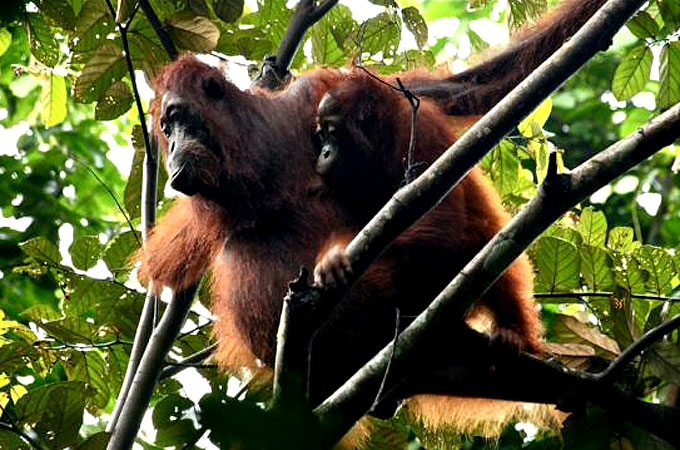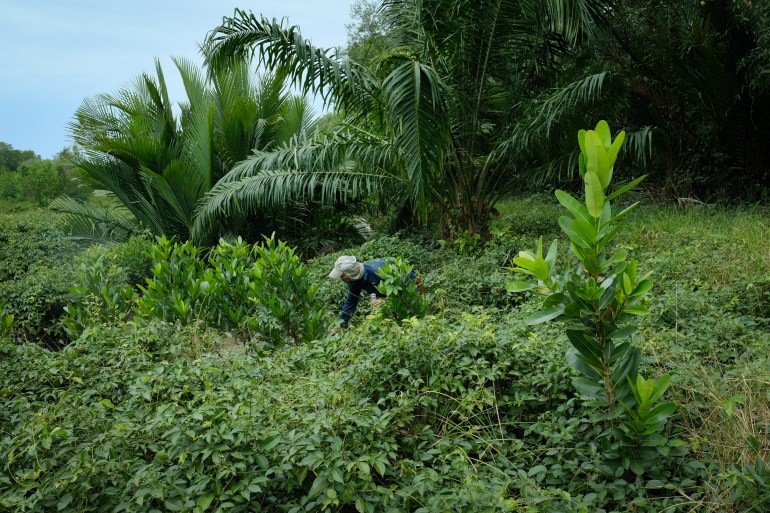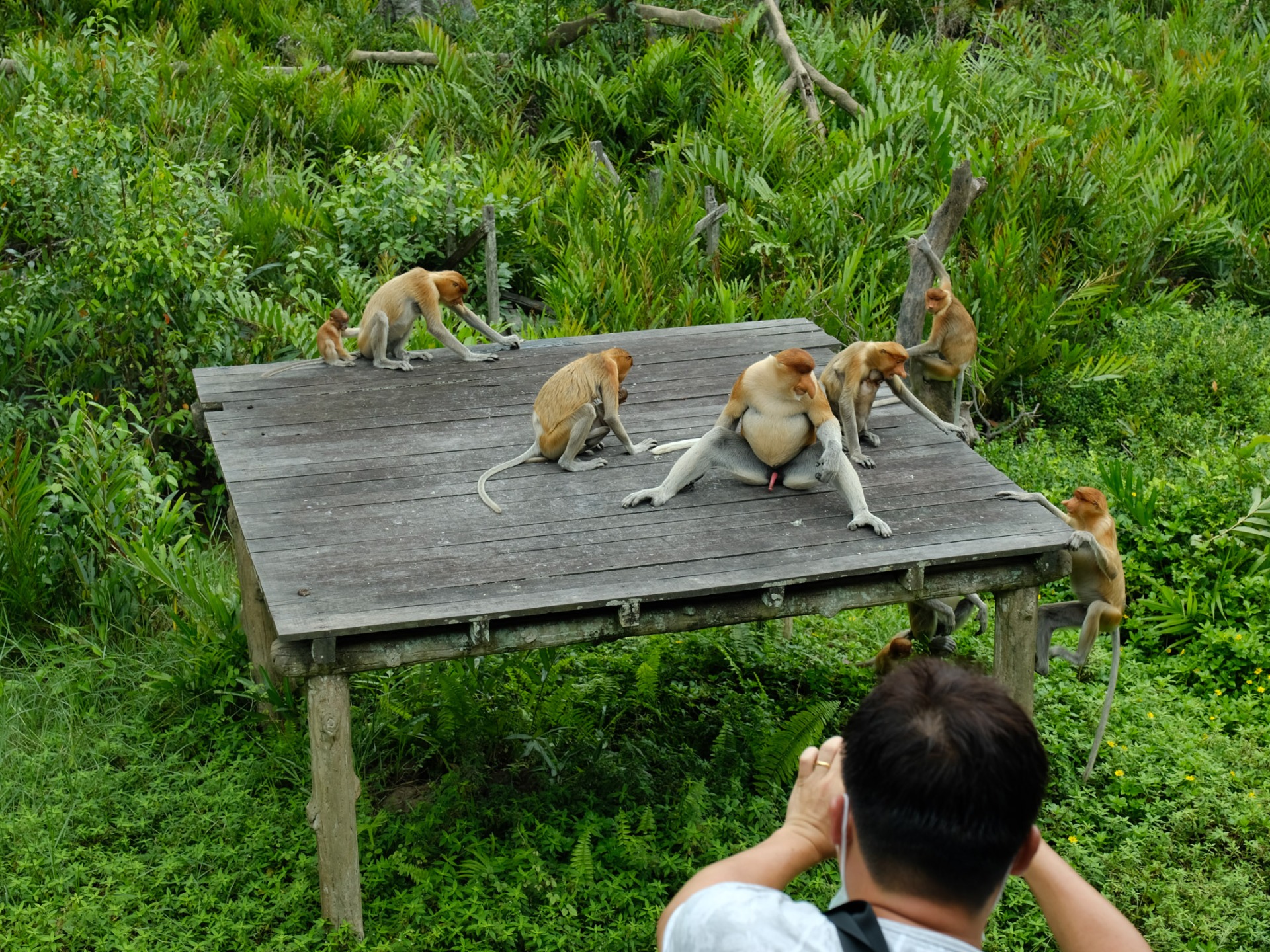Sabah, Malaysia – At the Labuk Bay Proboscis Monkey Sanctuary on the eastern coast of Sabah in Malaysian Borneo, you have to drive along kilometres of bumpy dirt roads flanked by columns of palm oil trees before arriving at a spot where you can watch the endangered monkeys feeding up close.
The sanctuary, which has grown to some 202 hectares (500 acres) of mangroves and is home to about 200 proboscis monkeys, is owned by a palm oil company and located on about 283 hectares (700 acres) of plantation.
Since 2000, the Yet Hing Plantation has been feeding the monkeys – endemic to Borneo and famous for their tawny-coloured fur and the males’ bulbous noses – and charging tourists to see them.
But it is now taking the endeavour more seriously.
In 2021, it acquired some 18 hectares (43 acres) – roughly the size of 33 football fields – of a neighbouring palm oil plantation that was unproductive and sought the expertise of the Sabah Forestry Department to plant 35,000 saplings of more than 20 mangrove species to extend the monkeys’ habitat.
The idea is to create a wildlife corridor – tracts of forest to connect natural landscapes split apart by agriculture and other human activity – for the animals and keep them away from the crops, while also protecting the plantation by providing a buffer against the risk of floods.
“We try to maintain the balance between economic activity and conserving the ecosystem of the mangroves along our plantation. The private sector can do it if they plan it properly,” said 69-year-old Michael Lee Hing Huat, who co-founded Yet Hing Plantation with his brother. “It’s not idealism or whatever. These two activities can come together.”
Such statements sit uneasily for some, especially when palm oil is seen as a key driver of deforestation. Indonesia and Malaysia together account for 85 percent of the world’s palm oil exports and both countries have been threatened with a boycott by other governments as well as consumers for unsustainable practices. Whether palm oil can be produced sustainably is a deeply divisive issue.
Animals in estates
In Malaysian Borneo, industrial palm oil development accounted for between 57 and 60 percent of all deforestation from 1973 to 2015, according to a 2018 report by the International Union for Conservation of Nature (IUCN).
The resulting habitat loss and fragmentation is a significant threat to the proboscis monkey as well as other iconic endangered species such as the pygmy elephant and orangutan. A 2019 study found that the proboscis monkey population along the Kinabatangan River, an important habitat for wildlife fragmented by plantations, was declining by 10 percent a year as a result of deforestation.

Moreover, in a world of finite land and ever-increasing consumption, palm oil plantations could double in area by 2050. According to the IUCN report, this could affect just more than half the at-risk mammal species around the world.
But palm oil has also been credited with lifting many smallholders out of poverty.
“For those who depend on oil palm as a source of income, they don’t see it in the bad light that folks overseas might. It is a crop that has helped many in rural areas send their children to university, and help them move upward to better lives – often as professionals,” said Serina Rahman, a lecturer at the National University of Singapore’s Southeast Asian Studies department.
“There are quite a number of locals who do believe that the foreign anti-palm oil campaigns are really just a ploy by those who produce their own vegetable oil, such as from corn or sunflower – an anti-global south thing,” she added.
Because of the socioeconomic benefits palm oil cultivation offers – as well as the fact that more and more wildlife is roaming in plantations – it is increasingly seen as necessary that palm oil be produced more sustainably and that agribusinesses take a more active role in conservation.
“When I first started, I always promised myself not to work with the palm oil industry. But now we cannot avoid working with them – at least for the elephants,” said Nurzhafarina Othman, the founder of the nonprofit Seratu Atai, which works with smallholders to minimise human-elephant conflict.
These animals need large areas to roam and in the last 40 years, 60 percent of natural elephant habitat in Sabah has been lost, mostly as forest is converted for agriculture.
Between 2010 and 2021, at least 200 elephants died – some of which were found to have been poisoned on or near palm oil plantations. The state authorities estimate there are fewer than 1,500 pygmy elephants left in Sabah.
Similarly, some 10,000 of the estimated 75-100,000 orangutans in Borneo, including the Indonesian part of the island, are now found on palm oil estates, according to the 2018 IUCN report.
For Marc Ancrenaz, an orangutan conservationist who co-founded the Sabah NGO Hutan and is a member of the IUCN Palm Oil Task Force, this is why it is better that animals are afforded more freedom of movement within plantations than translocated outside, except in exceptional circumstances. He says, however, that he still gets pushback on this view from some conservation partners.
Reducing conflict
In a collaboration since 2012 between World Wildlife Fund (WWF) Sabah and Sabah Softwoods (SSB), 7,000 of 60,000 hectares (148,263 acres) of the company’s timbre and palm oil plantations in Tawau have been set aside for conservation. This includes fragments of forest patches connected by a wildlife corridor running through the plantation, which is almost 14km (9 miles) long and 400 to 800 metres (1,312 to 2,624 feet) wide and which serves as a bridge to the Ulu Segama and Ulu Kalumpang forest reserves.
According to Ram Nathan, SSB’s senior manager for environment and conservation, the effort has not only helped the animals. The company has benefitted too.
During a WWF webinar, he reported that the cost of crop damage to the company from human-elephant conflict fell from some 500,000 Malaysian ringgit ($108,260) a year between 2004 and 2011, to 5,000 Malaysian ringgit ($1,072 in 2018.
Similarly, Hutan is working with Melangking Oil Palm Plantation (MOPP), which covers 8,000 hectares (19,768 acres) in the Kinabatangan area, in setting aside 500 hectares (1,235 acres) for conservation.
Unlike with SSB and MOPP, it is usually the conservationists who make the initial approach, but both sides are now engaging more with one another. “A few years ago, NGOs wouldn’t talk to plantations and plantations wouldn’t talk to NGOs. But things are changing a little,” Ancrenaz said.
This could be due to the reputational beating palm oil has been taking globally as well as the Sabah government’s declaration that palm oil operations in the state must be certified by the Roundtable for Sustainable Palm Oil (RSPO) – which requires that companies set aside plantation areas for conservation – by 2025. (At the moment, just 26 percent of operations in Sabah are RSPO-certified.)
It is also particularly good timing now, said Nurzhafarina, because oil palm trees have a life cycle of 25 years and many plantations are currently replanting. “When they replant, there are a lot of opportunities to kind of rearrange the landscape,” she said.
Benoit Goossens, the director of the Danau Girang Field Centre, a scientific research station in the Kinabatangan area, said plantations have also realised that setting aside land for conservation benefits their crops. Keeping a band of forests along the riverbanks in the Kinabatangan area, for instance, provides protection from erosion.
And of course, it is also good publicity for plantations facing questions over their environmental impact.
“I think they also realised that some of the areas they are exploiting are underproductive, so they can more easily decide to put it aside for conservation,” Goossens added.
More recently, a couple of palm oil plantations – including Labuk Bay – have introduced tourism into the mix.
The Sanctuary – as it is called, although it is not technically a rescue centre – came about accidentally.
As Lee of Yet Hing Plantation tells it, in 1997 the labourers would prepare pancakes every day before heading out to the fields. One day, they found their pancakes missing when they returned for lunch. The culprits: proboscis monkeys.
Aware that wildlife sighting tours were becoming more popular, Lee and his brother decided to leave the initial 263 hectares (650 acres) of mangroves within the plantation intact and started feeding the monkeys pancakes (without sugar), cucumbers and long beans – before inviting tourists in.
However, Lee said the plantation’s latest mangrove rehabilitation effort with the Sabah Forestry Department (SFD) was done with the express intention of expanding the monkeys’ habitat.
‘Elephants are an asset’
The replanting programme is just one of many sites that form part of the SFD’s ongoing collaboration with the International Society for Mangrove Ecosystems (ISME), a nonprofit based in Japan, which began in 2011 and ends in 2024. The project aims to rehabilitate 50 hectares (123 acres) of degraded mangroves annually in the state – on abandoned palm oil plantations and abandoned aquaculture farms as well as illegally encroached areas.
Joseph Tangah, a mangrove expert with the forestry department who leads the ISME partnership, said the Yet Hing Plantation owners were the ones who approached the department with the idea. “Palm oil, not forest, is their bread and butter. So the best way they can help is to cooperate with the SFD for their rehabilitation project,” he said.

More recently, in 2018, Sabah Softwoods Berhad joined hands with tour operator 1StopBorneo Wildlife to offer elephant safaris through their plantation. As part of their day tour, tourists also plant seedlings of fig and other fruit trees along the plantation’s wildlife corridor. These serve as a food source for elephants and other wildlife to deter them from eating young palms.
According to 1StopBorneo Wildlife founder Shavez Cheema, between 60 and 80 elephants roam in and around the plantations. Though sightings of elephants were not guaranteed, Shavez said: “We have done 99 safaris and we’ve seen them on 89 occasions. So, in conclusion, the best place to see elephants at this present time in Borneo is this project site and the Kinabatangan.”
Shavez added that the tours were effective in covering the loss from crop damages caused by elephants, having brought in 30,000 Malaysian ringgit ($6,437) in one year for the plantation.
“We want to inform plantations that elephants are an asset, not a liability, that you can make money out of them,” he said. However, he added that the tours have been paused since earlier this year after a change of management at the plantation.
Lee of Yet Hing Plantation also sees tourism as a way to recoup some of the costs of mangrove rehabilitation, although he adds that the Sanctuary has not made much of a profit in the past 10 years. He knows some find this pragmatism distasteful and is candid about criticisms likening Labuk Bay to a “zoo”. But he claims their efforts have worked because the monkeys’ numbers have now doubled.
However, Nurfazina of Seratu Atai, who has been studying pygmy elephants for years, has her reservations about such tourism activities.
“To be honest, I think if we want to conserve wildlife, we have to do it genuinely, because they have the right to live as we do – not because they have monetary value,” she said. “Tourism is good, but sometimes tourism can also be very cruel, you know, towards the welfare of elephants.”
Benoit Goossens, the Danau Girang Field Centre’s director, thinks proper rules and regulations are needed.
“Protecting the mangroves instead of transforming them into a plantation, for example, and then bringing tourism in, I think that’s a good idea. But the rules and regulations, particularly the distance observed between humans and wildlife, should be well established,” he said.
Augustine Tuuga, the director of the Sabah Wildlife Department, told Al Jazeera in an email that it had granted the Labuk Bay Proboscis Monkey Sanctuary permission and guidelines to be developed into a tourism destination.
“The development of wildlife tourism-related activities in plantations’ [conservation] areas must first and foremost be communicated to the Wildlife Department in order to obtain the guidelines and advice from the department on the proper management of its wildlife and habitat to prevent any adverse impacts,” he added.
Whether there is room for tourism on plantations, for the moment many conservationists in Sabah say the coexistence of humans and wildlife is necessary as well as possible.
“I’m an orangutan conservationist and I talk about the palm oil industry and I’m trying to say, well, there may be some hope there,” said Ancrenaz.
For this reason, he insists Hutan does not take money from the plantations they work with and that their work is funded instead by zoos and private foundations – although the plantations will pay for some of the work to be done on their grounds, such as their staff’s salaries for monitoring seedlings. “Some people think that we say what we say because we have a direct interest but it’s not the case. It’s not a financial interest.”

Recorded mammal diversity in palm oil plantations is between 47 and 90 percent lower than in natural forest and strongly depends on the proximity of such habitat. But where forests no longer exist, conservationists say some species have proven to have a surprising ability to adapt.
“If the forest was there, it would be better, obviously. But because it’s not there and that’s the situation we have, we need to work hand in hand with plantations to try to make things better,” Goossens said.
Still, there remain unknowns and possible trade-offs. Scientists at the Danau Girang Field Centre have found, for instance, that there is a higher accumulation of heavy metals in civets that live on plantations compared with those that live in forests, which could undermine their long-term population viability.
What is clear is that wildlife do not understand human land boundaries. In Hutan’s ongoing collaboration with the Melangking Oil Palm Plantation, the NGO has to work not just with MOPP but also with neighbouring plantations – because if electric fencing is not planned at a landscape level, it can lead to bottlenecks that can make human-wildlife conflict worse – as well as surrounding smallholders and villagers who live in proximity with displaced wildlife.
“So actually, conservation is really not about animals. It’s about people,” Ancrenaz said.
This story was produced with support from the Rainforest Journalism Fund in partnership with the Pulitzer Center.
Sumber: www.aljazeera.com
 Skip to content
Skip to content

